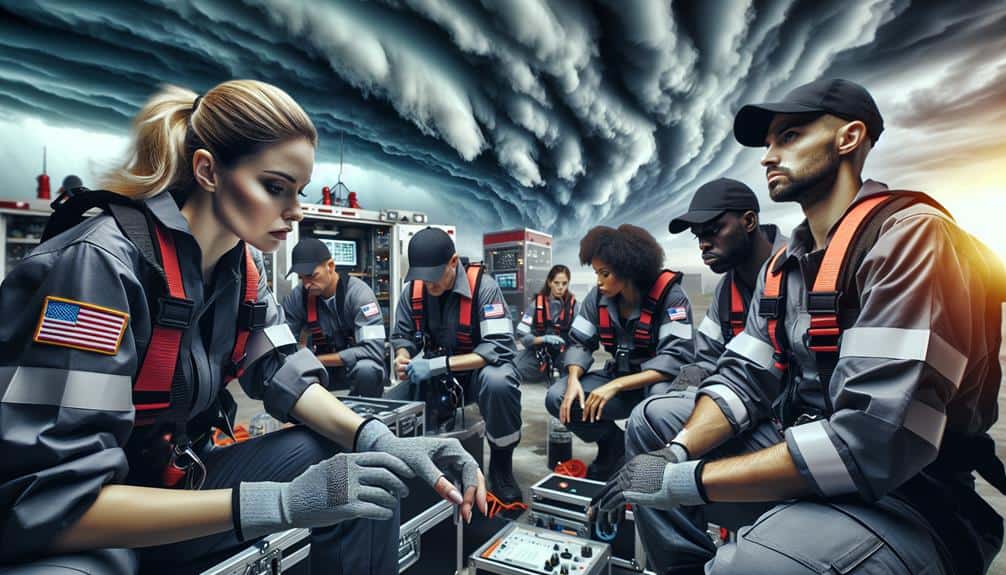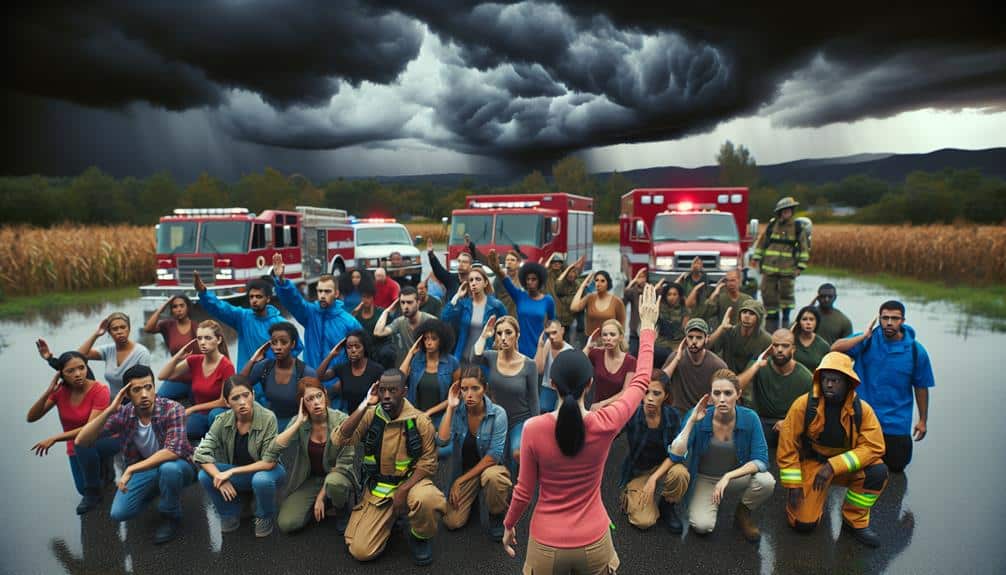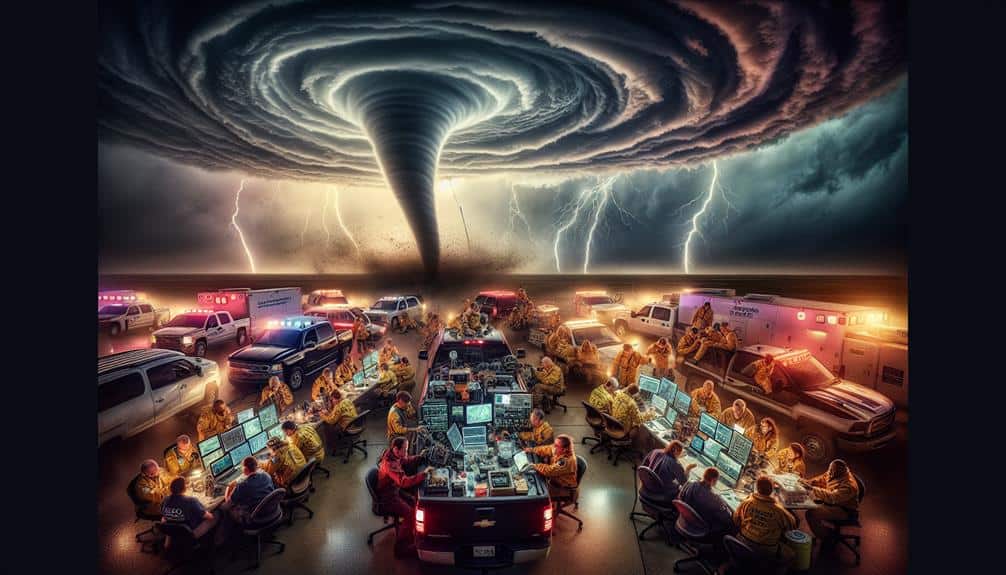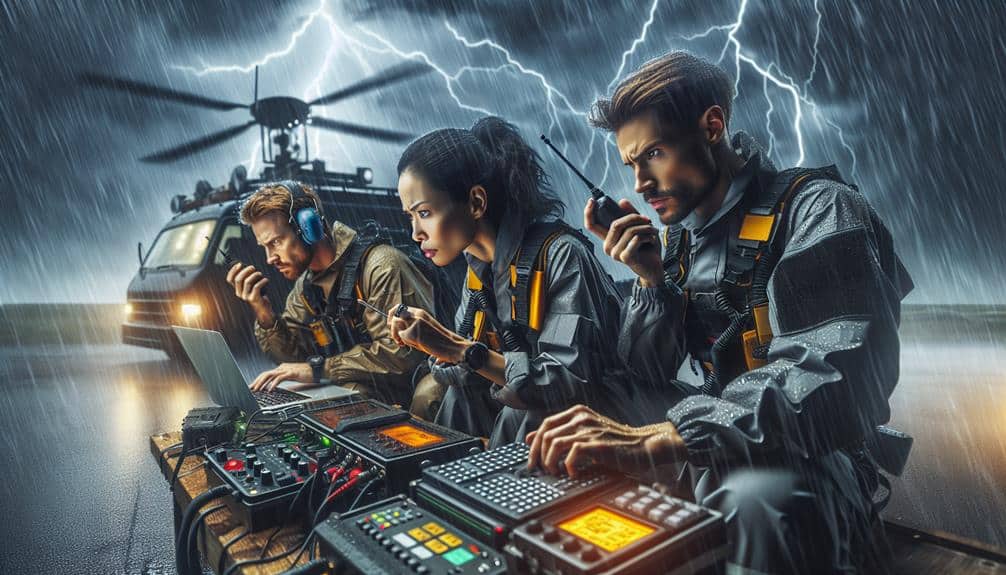Coordinating storm chasing evacuations demands precise strategies. We implement strong communication protocols using reliable tools like radios and GPS trackers, making sure real-time weather updates flow seamlessly. Identifying and securing safe zones are essential, favoring fortified buildings with ample supplies. Thorough evacuation routes, updated with GPS and traffic data, help us avoid high-risk zones. Regular team drills, cross-training, and collaboration with local authorities enhance our readiness. Real-time storm monitoring and maintaining calm under pressure are crucial. By integrating these techniques, we refine our evacuation plans and guarantee safety, benefiting both operational effectiveness and decision-making agility. Let's explore deeper strategies ahead.
Key Points
- Implement robust emergency protocols with reliable communication tools like radios and GPS trackers.
- Identify and verify secure areas as safe zones, ensuring they are fortified and accessible.
- Continuously monitor weather conditions using real-time storm tracking tools for swift adaptation.
- Plan and practice evacuation routes with GPS and traffic monitoring systems for real-time updates.
Establish Clear Communication
Effective coordination during storm chasing evacuations hinges on establishing clear and consistent communication channels among all team members. We must implement robust emergency protocols that prioritize seamless team communication. This involves using reliable communication tools such as radios and GPS trackers. These tools enable us to relay real-time weather updates and adjust evacuation procedures promptly. Each team member should have a role in our communication strategy, ensuring no information bottlenecks occur.
When we're facing volatile weather conditions, instant access to updated forecasts and storm paths is non-negotiable. Our communication system should integrate these updates directly, allowing us to make informed decisions on the fly. Establishing pre-defined codes for common scenarios can further streamline our interactions, minimizing misunderstandings during critical moments.
Furthermore, we should conduct regular drills to practice our emergency protocols. These drills will help us identify any weaknesses in our communication infrastructure and refine our evacuation procedures accordingly. By maintaining this level of preparedness, we'll enhance our ability to respond swiftly and effectively to sudden changes in weather conditions.
In the high-stakes environment of storm chasing, clear communication is our lifeline, ensuring everyone's safety and operational success.
Designate Safe Zones
We must meticulously identify and designate secure areas where our team can regroup and seek shelter during extreme weather events. These locations must be pre-determined based on their structural strength and accessibility. Safe shelters should be fortified buildings, ideally constructed to withstand strong winds and offer protection from flying debris.
Our evacuation procedures should include detailed maps and GPS coordinates of these secure areas. Each member of our team needs to be familiar with these locations and the routes to reach them swiftly and safely. We should prioritize areas that are easy to access from multiple directions, reducing the risk of being blocked off by sudden changes in the storm's path.
Furthermore, we must assess the capacity of these shelters to ensure they can accommodate our entire team. It's also important to verify that these locations have basic amenities, such as emergency supplies, first aid kits, and communication tools, to sustain us during prolonged stays if necessary.
Utilize Reliable Weather Data
Dependable weather data forms the backbone of our storm chasing strategy, enabling us to make informed decisions and guarantee our safety. Accurate weather prediction is vital for our operations. We rely on the latest meteorological models and real-time data to predict storm paths and intensities. This ensures we stay ahead of severe weather, minimizing risks and optimizing our emergency response coordination.
In our data analysis techniques, we integrate various sources, including satellite imagery, Doppler radar, and ground-based observations. This multi-faceted approach enhances weather prediction accuracy, allowing us to refine our evacuation planning. By continuously monitoring weather conditions, we can adapt our plans swiftly, safeguarding everyone's safety in rapidly changing situations.
Moreover, we utilize advanced software to visualize data trends and forecast models. These tools help us identify potential threats and prepare accordingly. The precision of our data analysis techniques directly impacts our ability to make quick, effective decisions during storm chasing expeditions.
In essence, leveraging dependable weather data is essential. It empowers us to coordinate emergency responses effectively, execute evacuation plans seamlessly, and maintain the freedom to explore severe weather phenomena without compromising safety.
Develop Evacuation Routes
Establishing clear and adaptable evacuation routes is important for guaranteeing swift and safe responses during storm chasing expeditions. We need to prioritize careful evacuation planning to account for potential road closures and guarantee smooth traffic management.
To start, we should analyze geographical data to identify primary and secondary routes. These routes must be adaptable based on real-time conditions.
Next, integrating technology is essential. Utilizing GPS and traffic monitoring systems helps us stay updated on road conditions and closures. We can then reroute our team efficiently, avoiding congested or damaged roads. It's essential to plan alternate pathways that circumvent high-risk areas likely to be affected by the storm.
Additionally, we must identify and mark the locations of emergency shelters along our planned routes. These shelters provide safe havens if conditions deteriorate rapidly. We should collaborate with local authorities to guarantee these shelters are accessible and equipped.
Regularly updating our evacuation plans ensures we remain prepared for dynamic storm patterns. By systematically addressing road closures, traffic management, and emergency shelters, we can maximize our mobility and safety during storm chasing expeditions.
This proactive approach empowers us to make informed, swift decisions, preserving both freedom and safety.
Train Team Members

Training team members thoroughly prepares them to effectively respond to dynamic and hazardous storm conditions. We need to focus on in-depth simulation exercises that replicate real-world scenarios. These exercises enhance our team's ability to make quick, informed decisions under pressure. By integrating team building activities, we strengthen interpersonal bonds, ensuring seamless cooperation during emergencies.
Effective communication strategies are paramount. We should establish clear protocols for both verbal and non-verbal communication. Using two-way radios and hand signals can eliminate misunderstandings in high-noise environments. Regular drills will help us practice these strategies, embedding them into our muscle memory.
Our emergency response plan must be adaptable. Each team member should be well-versed in multiple roles, allowing for flexibility in unforeseen circumstances. Cross-training not only increases our operational resilience but also empowers each individual with a sense of autonomy and confidence.
Equip Emergency Kits
We need to make sure our emergency kits are fully equipped with essential survival items and thorough first aid supplies. This preparation can greatly enhance our team's safety and effectiveness during storm chasing evacuations.
Let's analyze the critical components, starting with basic necessities and medical provisions.
Essential Survival Items
Every emergency kit should contain essential items such as water, non-perishable food, a first aid kit, a flashlight, batteries, and personal medications.
To make sure we're prepared for any scenario, we need to focus on equipping our kits with items that address immediate survival needs. Prioritizing emergency shelter is vital. A compact, lightweight tent or a durable emergency blanket can provide necessary protection against the elements, keeping us safe and dry.
When selecting food supplies, opt for high-calorie, non-perishable options. Protein bars, canned goods, and freeze-dried meals are excellent choices. These should be easy to store and require minimal preparation. Don't forget to pack a manual can opener if needed. Hydration is just as important. We should include at least one gallon of water per person per day, ideally enough to last for at least three days.
In addition to these basics, let's consider adding items like multi-tools and personal hygiene products. A well-rounded emergency kit enhances our ability to remain self-sufficient and make quick decisions when faced with the unpredictable nature of storm chasing.
First Aid Supplies
To make sure immediate medical needs are met during a storm chase, our emergency kits must include an extensive first aid supply. Properly equipping our kits guarantees that we're prepared for any situation, from minor scrapes to more severe injuries requiring wound care. An effective emergency response relies on having the right tools at hand.
Key items in our first aid kit should include:
- Adhesive bandages and sterile gauze: Essential for basic wound care and dressing minor injuries.
- Antiseptic wipes and ointment: Essential for cleaning wounds to prevent infection.
- CPR mask and gloves: Essential for performing CPR safely, especially if we're certified in CPR training and first aid.
Our readiness isn't just about having the right items; it's also about knowing how to use them. Before heading out, let's make sure everyone on the team holds a current first aid certification. This training boosts our confidence and effectiveness during an emergency response.
Coordinate With Local Authorities

Regularly working together with local authorities guarantees that evacuation plans are synchronized and effectively executed during storm pursuing operations. Our primary focus must be aligning our strategies with the established emergency response protocols of the regions we travel through. This guarantees that our actions don't inadvertently compromise local crisis management efforts.
To accomplish this, we need to establish clear communication channels with local emergency management offices before commencing any storm pursuing endeavor. By sharing our planned routes and expected movements, we enable local authorities to anticipate our needs and incorporate our presence into their broader emergency response strategies. This collaboration can include real-time updates on road closures, shelter availability, and any other essential information that could affect our evacuation procedures.
Furthermore, having a direct line to local law enforcement and emergency services allows us to swiftly adapt to changing conditions and receive immediate assistance if necessary. This proactive approach not only enhances our operational efficiency but also guarantees that we act responsibly, respecting the freedom and safety of the communities we encounter.
Monitor Storm Progress
Monitoring storm progress is critical to ensuring our safety and the success of our storm chasing operations. We need to employ advanced storm tracking technologies and stay updated on safety developments. This enables us to make informed decisions about when to execute our evacuation plans and where to locate emergency shelters.
To effectively monitor storm progress, we should:
- Utilize real-time storm tracking tools: Radar, satellite imagery, and storm prediction models provide up-to-the-minute information.
- Subscribe to safety updates: Alerts from meteorological agencies and local authorities keep us informed of any sudden changes.
- Maintain communication channels: Use radios, smartphones, and other devices to stay in touch with team members and receive updates.
Conduct Regular Drills

We need to conduct regular drills to simulate real-world scenarios and assess our readiness. By doing this, we can evaluate team performance and identify areas for improvement.
These drills will guarantee that we're prepared for any unexpected situations during storm chasing evacuations.
Simulate Real-World Scenarios
Conducting regular drills guarantees our storm chasing teams are prepared to execute evacuations efficiently and safely under real-world conditions. When we simulate real-world scenarios, we immerse ourselves in situations that test our readiness and adaptability. Emergency response training and role playing exercises are fundamental to these simulations, confirming our team members can act swiftly and decisively.
These exercises should incorporate a variety of challenging scenarios to enhance our preparedness:
- Severe weather conditions: Simulate tornadoes, hurricanes, and flash floods to test our adaptive strategies.
- Communication breakdowns: Practice handling situations where radio or mobile communications fail.
- Unexpected obstacles: Introduce sudden roadblocks or equipment failures to test problem-solving skills.
Evaluate Team Performance
Regularly evaluating team performance through drills maintains our storm chasing teams remain capable and responsive in high-stress situations. Conducting these drills confirms that our team communication and emergency response protocols are consistently refined and effective. By simulating various scenarios, we can identify gaps in our procedures and address them proactively.
During drills, we focus on real-time communication, confirming every team member knows their role and can execute it under pressure. Effective team communication is paramount; it prevents misunderstandings and enhances our collective decision-making process. We utilize both verbal and non-verbal cues to guarantee seamless information flow.
Emergency response drills also test our ability to quickly adapt to changing weather conditions. By analyzing our performance, we can pinpoint areas needing improvement, such as equipment readiness or evacuation routes. This continuous feedback loop fosters a culture of constant vigilance and preparedness.
We document each drill's outcomes, creating a repository of lessons learned. This documentation allows us to track progress and make data-driven decisions for future drills. Ultimately, these regular evaluations empower us with the freedom to chase storms confidently, knowing we're prepared for any emergency.
Maintain Calm Under Pressure
Staying composed during storm chasing evacuations is crucial for making swift, accurate decisions under pressure. As storm chasers, we face unpredictable and often volatile situations. To stay focused and remain composed, we must employ several strategies that ensure our team operates efficiently and safely.
Structured Communication: Establish clear, concise communication channels. This minimizes misunderstandings and guarantees all team members receive critical updates instantaneously.
Predefined Roles: Assign specific roles to each team member before the chase starts. Knowing who's responsible for what reduces confusion and streamlines operations.
Routine Drills: Conduct regular evacuation drills. Familiarity with procedures boosts confidence and performance when real emergencies arise.
Mindfulness Techniques: Incorporate stress-reduction techniques like deep breathing and mental rehearsals. These can help us maintain our composure during high-stress moments.
Frequently Asked Questions
What Safety Measures Should Be Taken When Encountering Wildlife During Evacuations?
During evacuations, we must prioritize wildlife awareness. For wildlife encounters, our safety measures should include maintaining distance, avoiding sudden movements, and not feeding animals. These precautions guarantee a safe evacuation while respecting wildlife.
How Can We Ensure Vehicle Reliability During a Sudden Evacuation?
Ensuring vehicle reliability during a sudden evacuation is like prepping a lifeline. We need to perform emergency maintenance checks and meticulous route planning. This guarantees our mobility and autonomy, safeguarding our freedom when it matters most.
Are There Specific Insurance Policies for Storm Chasing Teams?
Yes, there are specialized insurance policies for storm chasing teams. These policies offer extensive insurance coverage tailored to our unique needs, ensuring team protection against potential risks during operations. This guarantees our freedom to chase storms confidently.
What Are the Best Practices for Managing Fuel Supplies During an Evacuation?
In the spirit of ideal resource utilization, we need to prioritize fuel management by maintaining reserves and mapping refueling points. Additionally, let's remain vigilant about wildlife encounters, ensuring our safety while preserving our freedom to explore.
How Should We Handle Potential Roadblocks or Traffic During an Evacuation?
We should manage potential roadblocks or traffic by identifying alternate routes and detours in advance. Effective traffic control and coordination with local authorities will guarantee smooth passage and minimize delays, maintaining our freedom of movement.


